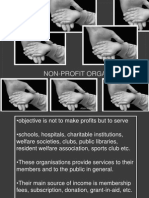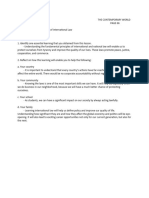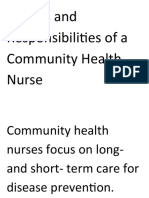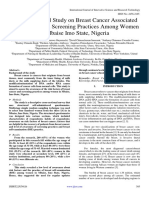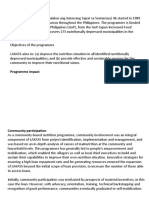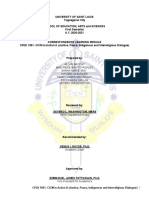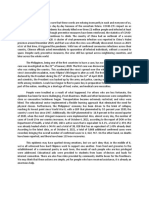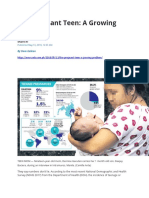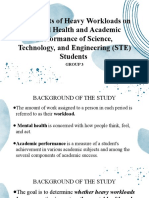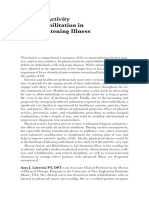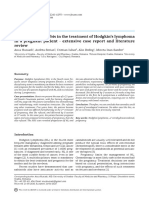0 ratings0% found this document useful (0 votes)
50 viewsChapter 1
Chapter 1
Uploaded by
Alfred Prime- Teenage pregnancy is a major issue in the Philippines, with 500 youths giving birth every day. It is considered a national social emergency.
- Factors that contribute to early pregnancy among teens include lack of access to sexual health services and education, poverty, and pressure to marry early.
- The COVID-19 pandemic has exacerbated the problem by making it harder for young girls to access education, increasing economic hardship, and potentially leading to more sexual abuse as families are confined at home.
Copyright:
© All Rights Reserved
Available Formats
Download as DOCX, PDF, TXT or read online from Scribd
Chapter 1
Chapter 1
Uploaded by
Alfred Prime0 ratings0% found this document useful (0 votes)
50 views6 pages- Teenage pregnancy is a major issue in the Philippines, with 500 youths giving birth every day. It is considered a national social emergency.
- Factors that contribute to early pregnancy among teens include lack of access to sexual health services and education, poverty, and pressure to marry early.
- The COVID-19 pandemic has exacerbated the problem by making it harder for young girls to access education, increasing economic hardship, and potentially leading to more sexual abuse as families are confined at home.
Original Title
CHAPTER 1
Copyright
© © All Rights Reserved
Available Formats
DOCX, PDF, TXT or read online from Scribd
Share this document
Did you find this document useful?
Is this content inappropriate?
- Teenage pregnancy is a major issue in the Philippines, with 500 youths giving birth every day. It is considered a national social emergency.
- Factors that contribute to early pregnancy among teens include lack of access to sexual health services and education, poverty, and pressure to marry early.
- The COVID-19 pandemic has exacerbated the problem by making it harder for young girls to access education, increasing economic hardship, and potentially leading to more sexual abuse as families are confined at home.
Copyright:
© All Rights Reserved
Available Formats
Download as DOCX, PDF, TXT or read online from Scribd
Download as docx, pdf, or txt
0 ratings0% found this document useful (0 votes)
50 views6 pagesChapter 1
Chapter 1
Uploaded by
Alfred Prime- Teenage pregnancy is a major issue in the Philippines, with 500 youths giving birth every day. It is considered a national social emergency.
- Factors that contribute to early pregnancy among teens include lack of access to sexual health services and education, poverty, and pressure to marry early.
- The COVID-19 pandemic has exacerbated the problem by making it harder for young girls to access education, increasing economic hardship, and potentially leading to more sexual abuse as families are confined at home.
Copyright:
© All Rights Reserved
Available Formats
Download as DOCX, PDF, TXT or read online from Scribd
Download as docx, pdf, or txt
You are on page 1of 6
Nowadays teens have a high number in early pregnancy and it
risks their health. Also, it affects their baby. Some of the cases
are premature birth, low birth weight. The baby will not complete
their development in the bodies and brains. This can lead to
lifelong issues with health and development, depending on how
premature the baby is. Young pregnant mothers also have a
higher chance to become anemic (Carey & Schulman, 2018).
For the U.S. component of flourishing and human associations
(HHS), maternal achievement and thriving contradictions are key
prerequisites. Our commitment proceeds through propelling
assessment at the Public Establishments of Success to address
dangerous pregnancy traps. As a rule, at standard stretches, a
lady bombs frightfully from disorders from pregnancy or
envisioning successors, as exhibited by the Organizations for
Powerful contravention and Avoidance and 60% of these passes
are preventable. Faint and Neighborhood American/Gold country
Close by ladies are around different events as committed to
kicking the bowl from a pregnancy-related clarification, standing
apart from white ladies, Hispanic ladies, and Asian/Pacific
Islander ladies. Starting at now, with the additional worries of the
Covid-19 pandemic, there is essentially more we have to know to
help guarantee with sounding pregnancies and solid children.
Since SARS-CoV-2, the tainting that causes Coronavirus, is new,
we need to find a few solutions concerning its short-and extended
length effect on pregnant ladies and their youngsters. NICHD
beginning late dispatched an assessment to comprehend the
impacts of the Coronavirus pandemic during and after pregnancy.
SARS-CoV-2 tends to another test and a function to guarantee
that we review pregnant ladies for research, address exceptional
concerns identified with pregnancy, and make structures that
permit us to follow extended length results (Fink & Bianchi, 2020).
Even before Covid-19 there are many women dying because of
complications and childbirth, deaths in 2019 increase now by
26%. The rate of unintended pregnancy can increase up to 42%
from 2019. They are women ages from 15-48 years old, they
don't want to be pregnant but they also are not using
contraceptive materials. The Philippines has the highest rates of
births in Asia due to Covid-19. Last year this was described as a
national social emergency. Because of the covid-19 this year may
end up having more teenage girls being pregnant. Sexual and
physical violence this year may increase, since we have been
stuck in our houses for months and for others they also stuck with
abusers in their own homes. This challenge is also for
governments to maintain the health services facilities for women
in family planning, using contraceptive materials and protections
during this pandemic (UNFPA, 2020).
There are many causes why teenagers got pregnant early so of
the cause are lack if information about sexual and reproductive
health and rights, inadequate access to service tailord to young
people, family, community and social pressure to marry, sexual
abuse, early and forced marriage, and las lack of education
(Teenage Pregnancy/Plan international, 2020).
The situation of the teenage pregnancy rate in the Philippines has
been called a national social emergency. Youths that give birth
everyday are 500. The catholic bishops conference of the
Philippines remind the youth to enjoy being youth they should
know their limitations. That we shouldn't allow ourselves to
curiosity that we will regret at the end. And that Sex should be
done in marriage and not be done before marriage (POPCOM,
2020).
This pandemic makes the lives of every family harder. This
pandemic started last December in Wuhan China. It affects many
countries like the Philippines. The most vulnerable are the
children, especially girls, it is very hard to access the school to
learn in this time of pandemic. Poor children don't have enough
money to study. Being not able to study most of the young girls
spend their time entertaining men or boys, leading to greater
likelihood of engagement in risky sexual behavior. Because of
lack of information about premarital sex and poverty that is very
popular in our country many girls got pregnant at the age of 15-19
years old.(World Vision, 2020).
As stated by Atty. Kenneth Ocampo-Lantin, PYSPESO head,
These days young pregnancy is multifaceted and it's considered
as a public weight, which is the reason Gov. Daniel R Fernando
wanted to figure out how to reach out to the youth and their
parents knowingly that the vast majority remain at home due to
the COVID-19 we confronted. Furthermore, She added that
according to the Philippine Statistics Authority's 2019 Poverty
Indicator Survey, there were 2.97 million school youths in the
country out of school, so 61.9 percent of those are girls aged 16-
24 who married early and/or pregnant. In her talk, Patricia Ann
Alvaro, PHO-PH Provincial Health Education and Promotion
Officer and one of the resource speakers, said that teenage
parenthood is as much a global burden as it is locally. She said
21 million girls aged 15-19 get pregnant annually worldwide and
about 12 million give birth, with 770,000 of these births happening
to teenage girls younger than 15 years of age.
With the increase of higher education students, 10% of this
population are parents or mothers who like to give a better future
to their children and work for their family. Special attention should
be paid to mothers, since they are also mothers and caregivers at
home, apart from their position as students. After that, the student
mother will return to her studies because they want to provide
their children with everything (Wilsey, 2013).
Teenage pregnancy is the world's problem. But we need to be
aware of those student mothers, ages between 15 to 19 girls.
Because pregnant students need to lower in their necessity and
desires for their children and families. They would face the
struggles with the incompatible role of being mothes and a
studentship ( Berg & Mamhute, 2013)
Let us have a glimpse of the sad state of the Philippine Public
Healthcare System. The level of per-individual healthcare
spending in the country is one of the most minimal among
Southeast Asia's major economies while the nation's healthcare
spending is projected to increment annually (Folger, 2020). In
terms of specialist to-quiet ratio, the Philippines has one doctor
per 33,000 patients, and one hospital bed is available for every
1,121 Filipino patients. The question now is where to oblige those
who need to be isolated because of infectious diseases such as
COVID-19 not including others who need to be quarantined. This
data tells us that the Philippines is not really ready to Tight a
global pandemic. Our medical front liners have felt anxious,
especially medical specialists, nurses and lab technicians in the
last few days and weeks with the exponential increase of
Coronavirus 19 cases in the nation. As indicated by Lim (2020),
starting in 2017, there were 1,236 emergency clinics in the nation
65% of which were exclusive. WHO recommends 20 beds per
10,000 population but the Philippines had 14.4 beds per 10, 0000
in 1990 and only 9.9 beds per 10, 0000 population in 2014. Since
the virus was not contained within Manila where ii started and
reached to other regions, chances are there will be more people
who will be admitted to the hospitals all over the country and there
will be more people who should be quarantined and detached.
As mentioned above, medical staff have been complaining
already about the sad state of the Philippine Public Healthcare
System. Jocelyn Santos-Andamo, the secretary-general of
Filipino Attendants Joined together (FNU), a public association of
medical caretakers, said that the administration doesn't regard
wellbeing as a need and the effectively low wellbeing budget was
further cut which resulted in less clinical supplies, poorly
maintained medical equipment and understating even before
Coronavirus 19. Even previously Coronavirus 19, the public
health system was now deteriorating (Lim, 2020).
To intensify the state's Tight against the spread of Coronavirus
19, President Rodrigo Duterte declared a state of public health
emergency in the Philippines on March 9 due to the
confirmation of local transmission of the virus. Then, on March 12,
2020, the President decided to put the entire Manila on Enhanced
Community Quarantine and on March 15, 2020, he expanded it to
the entire country and closed its borders to foreigners. The
spokesperson The president clarified that "strict home
quarantine shall be implemented in all households, transportation
shall be suspended, provision of food and essential services will
be regulated, and heightened presence of formally dressed
personnel to enforce quarantine procedures will be implemented"
(Santos, 2020c). However, as expected, not all establishments
want to follow the "work from home scheme". Some
establishments (especially in the private sector) still asked their
employees to report to work by imposing a 'no work, no pay
policy'. In a society where a lot of people are really in need of
work, private establishments can even pride themselves of being
generous to the poor by giving them work notwithstanding
government's mandate not to require their employees to report to
work and instead to devise a 'work from homes' scheme.
The government did not also impose sanction to the
establishments for continuously requiring their employees to work
by imposing a 'no work, no pay' policy. Thus, for the poor and
those who are solely dependent on their daily work for survival,
they did not have a decision but to work and brave the
challenge of Coronavirus 19 infection just to let their family have
food to eat (Santos, 2020c).
You might also like
- Breast Imaging (Kopans, Breast Imaging) Third EditionDocument1,585 pagesBreast Imaging (Kopans, Breast Imaging) Third EditionTatiana Plescan100% (3)
- Family PlanningDocument22 pagesFamily PlanningDl MeenaNo ratings yet
- 100 Human Behavior QuestionsDocument9 pages100 Human Behavior QuestionsJen Paez75% (4)
- Ao 2020-0047Document41 pagesAo 2020-0047D Alfz EinsTein JDNo ratings yet
- Family PlanningDocument14 pagesFamily PlanningParpar IparNo ratings yet
- PerineumDocument20 pagesPerineumJoherNo ratings yet
- Routes of Drug Administration: Route Advantages Disadvantages OralDocument3 pagesRoutes of Drug Administration: Route Advantages Disadvantages OralRenita ChrisNo ratings yet
- University of Caloocan City: SSBC 112 Lesson No. 10-10 Week Topic: Dominant Approaches and Ideas of Social SciencesDocument6 pagesUniversity of Caloocan City: SSBC 112 Lesson No. 10-10 Week Topic: Dominant Approaches and Ideas of Social SciencesMaria Luisa Bantoy100% (1)
- PassionDocument3 pagesPassionJulie Ann MoinaNo ratings yet
- Fire DrillDocument39 pagesFire DrillRazib Bahadur SastriNo ratings yet
- BSN 1 3 Quiz BedmakingDocument1 pageBSN 1 3 Quiz BedmakingSTEPHANIE LEI BUENAOBRANo ratings yet
- FDA Pregnancy CategoriesDocument3 pagesFDA Pregnancy CategoriesHibiryen100% (1)
- Cesarean Section PatelDocument55 pagesCesarean Section Patelالوافي الذهبيNo ratings yet
- Route of Drug AdministrationDocument27 pagesRoute of Drug AdministrationRina MutiarasariNo ratings yet
- Anesthesia and TypesDocument6 pagesAnesthesia and TypesKat PerezNo ratings yet
- Family Planning MethodDocument22 pagesFamily Planning MethodPrince XianderNo ratings yet
- Artificial Family PlaningDocument252 pagesArtificial Family PlaningJonah nyachaeNo ratings yet
- Family PlanningDocument25 pagesFamily Planningatishdk100% (5)
- Social Problems in The Philippines I-Witness: "Black Manila", A Documentary by Howie SeverinoDocument1 pageSocial Problems in The Philippines I-Witness: "Black Manila", A Documentary by Howie SeverinoMhelai Dela CruzNo ratings yet
- Situation Analysis of Community Midwives ' Training in SindhDocument107 pagesSituation Analysis of Community Midwives ' Training in Sindhmidwifepak100% (1)
- RLE Activity 1 (Partograph)Document3 pagesRLE Activity 1 (Partograph)Cameron De GuzmanNo ratings yet
- Perineal CareDocument7 pagesPerineal CareAna Maria Teresa H RollanNo ratings yet
- Psychological Changes During PregnancyDocument26 pagesPsychological Changes During Pregnancy2yfkcp246gNo ratings yet
- Qualification of Good TeacherDocument2 pagesQualification of Good TeacherWiljohn de la CruzNo ratings yet
- Ethics of Family PlanningDocument6 pagesEthics of Family PlanningNikolai Bacungan100% (3)
- Session 17Document4 pagesSession 17Dan Mark Lavega OmadleNo ratings yet
- A. Pre-Pregnancy Health Care: Family PlanningDocument7 pagesA. Pre-Pregnancy Health Care: Family PlanningWilma BeraldeNo ratings yet
- TCW SamDocument7 pagesTCW Samrobliao31No ratings yet
- 8th National Nutrition SurveyDocument123 pages8th National Nutrition SurveyYowan05100% (1)
- Introduction To Maternal NursingDocument128 pagesIntroduction To Maternal NursingNathalina DeepikaNo ratings yet
- Scope of Midwifery Practice Concept Analysis PDFDocument6 pagesScope of Midwifery Practice Concept Analysis PDFKunal MahajanNo ratings yet
- CHN - JoyDocument3 pagesCHN - JoyJoy VelascoNo ratings yet
- Promoting Nutritional Health During Pregnancy 19-20Document25 pagesPromoting Nutritional Health During Pregnancy 19-20Tony KhattarNo ratings yet
- Administering Tetanus Toxoid VaccineDocument2 pagesAdministering Tetanus Toxoid VaccinechateNo ratings yet
- M104 - ExamDocument8 pagesM104 - ExamChrystal Anne Flores CorderoNo ratings yet
- The High-Risk Pregnant Client:: NCM 109 Handout # 1Document3 pagesThe High-Risk Pregnant Client:: NCM 109 Handout # 1ApRil Anne BalanonNo ratings yet
- Importance of Family Planning in IndonesiaDocument2 pagesImportance of Family Planning in IndonesiaIchvan MeisyNo ratings yet
- The Effect of Drugs On PregnancyDocument26 pagesThe Effect of Drugs On PregnancyVictoria MarionNo ratings yet
- Asthmatic DrugDocument2 pagesAsthmatic DrugSushmita VandariNo ratings yet
- 5 Roles and Responsibilities of A Community Health NurseDocument7 pages5 Roles and Responsibilities of A Community Health NurseJULIUS BORDONNo ratings yet
- Implementing Sex Education in PhilippinesDocument3 pagesImplementing Sex Education in Philippinescathy cajegasNo ratings yet
- The Role of LGUs, Local Councils During DisastersDocument9 pagesThe Role of LGUs, Local Councils During DisastersJoel TalayNo ratings yet
- Philippine National Formulary As of February 2019Document62 pagesPhilippine National Formulary As of February 2019kkabness101 YULNo ratings yet
- Pulse Points Nursing Assessment PDFDocument8 pagesPulse Points Nursing Assessment PDFERANo ratings yet
- Handling Instruments During The Surgical ProcedureDocument4 pagesHandling Instruments During The Surgical ProcedureR-o-N-n-e-l100% (1)
- Expanded Program On ImmunizationDocument4 pagesExpanded Program On ImmunizationKrizle AdazaNo ratings yet
- Epidemiological Study On Breast Cancer Associated Risk Factors and Screening Practices Among Women in Mbaise Imo State, NigeriaDocument8 pagesEpidemiological Study On Breast Cancer Associated Risk Factors and Screening Practices Among Women in Mbaise Imo State, NigeriaInternational Journal of Innovative Science and Research TechnologyNo ratings yet
- Policy On Family PlanningDocument2 pagesPolicy On Family PlanningLILIW RHUNo ratings yet
- Problems and Solution 1 PDFDocument19 pagesProblems and Solution 1 PDFKristine M. MosqueraNo ratings yet
- Benefits of Family Planning in The PhilippinesDocument6 pagesBenefits of Family Planning in The PhilippinesYaniNo ratings yet
- Primary Health Care Maternal & Child HealthDocument32 pagesPrimary Health Care Maternal & Child HealthAbidah Rahmi HilmyNo ratings yet
- Presentation 1Document20 pagesPresentation 1aurora jimenezNo ratings yet
- Determining-Gravidity-And-Parity and How To Solve For AOG and EDDDocument15 pagesDetermining-Gravidity-And-Parity and How To Solve For AOG and EDDJoseph Hechanova AsenjoNo ratings yet
- Acknowledgement, Intro, Profile, Directory, Economic ProposalDocument34 pagesAcknowledgement, Intro, Profile, Directory, Economic ProposalMelody Kaye MonsantoNo ratings yet
- Essential Newborn Care ProtocolDocument23 pagesEssential Newborn Care ProtocolKaren Viviene CincoNo ratings yet
- Teenage PregnancyDocument2 pagesTeenage PregnancyKedi BoikanyoNo ratings yet
- 3.3 Integrated Management of Childhood Illness PDFDocument11 pages3.3 Integrated Management of Childhood Illness PDFVernonDimalNo ratings yet
- History of Present IllnessDocument43 pagesHistory of Present IllnessMaritoni CamilleNo ratings yet
- Allan Baccay Mae Irene Bautistazales Sarah Marie Ibay Hayden Gonzales Farry James Macarilay Esperanza Zablan Severo WashingtonDocument10 pagesAllan Baccay Mae Irene Bautistazales Sarah Marie Ibay Hayden Gonzales Farry James Macarilay Esperanza Zablan Severo WashingtonBrent Glenn Datu RoseteNo ratings yet
- MILDocument1 pageMILChares MarucutNo ratings yet
- COVIDDocument4 pagesCOVIDJoNo ratings yet
- The Pregnant Teen: A Growing Problem?: Share It!Document15 pagesThe Pregnant Teen: A Growing Problem?: Share It!MiyangNo ratings yet
- TN PG Man QuotaDocument26 pagesTN PG Man QuotatanishmuruNo ratings yet
- Invitation To The Life Span: Chapter 11 - Body, Mind, and Social WorldDocument38 pagesInvitation To The Life Span: Chapter 11 - Body, Mind, and Social WorldAshley VillalobosNo ratings yet
- Kidney TreatmentDocument7 pagesKidney TreatmentSubhasish Chatterjee0% (1)
- Examining The Influence of Budget Execution Processes On The Efficiency of County Health Systems in KenyaDocument12 pagesExamining The Influence of Budget Execution Processes On The Efficiency of County Health Systems in KenyaMike TeeNo ratings yet
- Training ProgramDocument12 pagesTraining ProgramGiovanni Delli SantiNo ratings yet
- Quantec Viz MareDocument16 pagesQuantec Viz MareFlorentina MovilaNo ratings yet
- Patch Adams Questions and AnswersDocument8 pagesPatch Adams Questions and AnswersRonaldo ManaoatNo ratings yet
- Gestational Trophoblastic DiseaseDocument25 pagesGestational Trophoblastic Diseaseapi-370504650% (2)
- "After All, There Is Nothing As Interesting As People, and One Can Never Study Them Enough" Vincent Van GoghDocument38 pages"After All, There Is Nothing As Interesting As People, and One Can Never Study Them Enough" Vincent Van GoghAnonymous 1gH7ra9ANo ratings yet
- Liver CirrhosisDocument14 pagesLiver CirrhosisCharissa Magistrado De LeonNo ratings yet
- 115 Part BDocument5 pages115 Part Bapi-662326591No ratings yet
- Test Bank For Pharmacology For Nurses, 2nd Edition: Michael P. AdamsDocument38 pagesTest Bank For Pharmacology For Nurses, 2nd Edition: Michael P. Adamsvujintatek100% (1)
- Exam 1 Notes Kin 247Document9 pagesExam 1 Notes Kin 247Steve ANo ratings yet
- India WHO-Cancer ProgrammeDocument10 pagesIndia WHO-Cancer ProgrammeMunish DograNo ratings yet
- Effect of Galohgor Cookies and Powder Drinks On ViDocument8 pagesEffect of Galohgor Cookies and Powder Drinks On ViKhaerul FadlyNo ratings yet
- FW Anilox + Cleaner C2 - ENG - 20150916Document10 pagesFW Anilox + Cleaner C2 - ENG - 20150916undying4lifeNo ratings yet
- Hospital PharmacyDocument20 pagesHospital PharmacyMarie Claire PundavelaNo ratings yet
- Module 2 Topic 2 EENC 1Document21 pagesModule 2 Topic 2 EENC 1Jade BalanNo ratings yet
- Microbial Diseases of The Respiratory SystemDocument9 pagesMicrobial Diseases of The Respiratory SystemAnaNo ratings yet
- Pharmacy Program StandardsDocument58 pagesPharmacy Program Standardsizzykhal75% (4)
- OPPE & FPPE Joint Commission Standards - HuntDocument11 pagesOPPE & FPPE Joint Commission Standards - HuntUwie Ana100% (1)
- 05 Impact On Climate Student EducationDocument10 pages05 Impact On Climate Student Educationcincincintami05No ratings yet
- Group3Document20 pagesGroup3Alyssa CuellarNo ratings yet
- 10 Keys Grounding PDFDocument20 pages10 Keys Grounding PDFDanielaMunioz100% (3)
- VNR Report IndonesiaDocument786 pagesVNR Report Indonesiaayahnya ale&azaNo ratings yet
- TDR Business Plan 2008-2013: Robert RidleyDocument43 pagesTDR Business Plan 2008-2013: Robert RidleySripal JainNo ratings yet
- PreviewpdfDocument56 pagesPreviewpdfDarshan ModhNo ratings yet
- O Efeito Da Cannabis No Tratamento Do Linfoma de HodgkinDocument6 pagesO Efeito Da Cannabis No Tratamento Do Linfoma de Hodgkinannacarolina.mmNo ratings yet

















